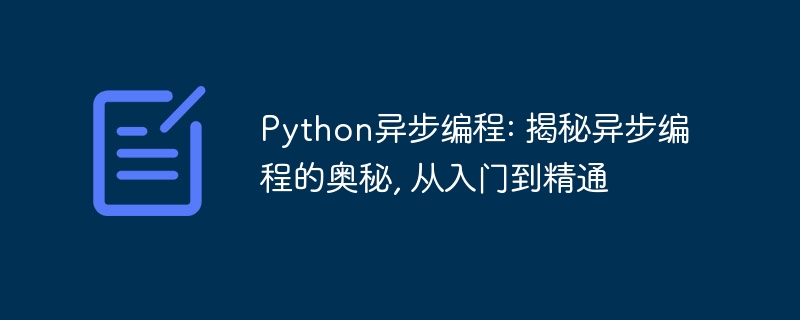

Asynchronous programming is a programming paradigm that allows a program toconcurrentlyperform multiple tasks without blocking. Unlike traditional synchronous programming, in asynchronous programming, when a task needs to wait for other tasks to complete, it will not be blocked, but can continue to perform other tasks. This way, the program can handle multiple tasks simultaneously, thereby improving the overall performance of the program.
Python3.4 and later support asynchronous programming. Asynchronous programming is mainly implemented in Python through coroutines and asynciomodules. A coroutine is a special function in Python that allows a program to pause and resume execution without blocking. The asyncio module is an asynchronous programmingframeworkin Python. It provides a variety oftoolsandapito enabledevelopersto easily Write asynchronous programs.
The asyncio module provides a variety of asynchronous programming primitives, including coroutines, event loops, tasks, and futures. The basic usage of asyncio is introduced below.
Coroutines are the basic building blocks in asyncio. A coroutine is a special function in Python that can be suspended and resumed. Coroutines are declared via theasync defkeyword, for example:
async def hello_world(): print("Hello, world!")
The event loop is the core component of asyncio. The event loop is a continuously running loop that is responsible for scheduling the execution of coroutines. When a coroutine needs to wait for other tasks to complete, it is suspended while the event loop continues executing other coroutines. When other tasks are completed, the event loop will resume execution of the suspended coroutine.
Task is the abstraction used in asyncio to manage coroutines. Tasks can be created, started, canceled and awaited. Tasks can be created through theasyncio.create_task()function, for example:
task = asyncio.create_task(hello_world())
Future is an abstraction in asyncio for representing the results of asynchronous operations. Futures can be awaited to obtain the results of asynchronous operations. The future can be created through theasyncio.Future()function, for example:
future = asyncio.Future()
In addition to coroutines, event loops, tasks, and futures, asyncio also provides many other advanced usages, including concurrency control, timeouts, cancellation, and exception handling. These advanced usages can help developers write more robust and efficient asynchronous programs.
Asynchronous programming has the following advantages:
Asynchronous programming also has some disadvantages:
Asynchronous programming is an effective programming method that can improve program performance, scalability and code readability. Asynchronous programming in Python can be achieved through coroutines and the asyncio module. The asyncio module provides a rich API that enables developers to easily write asynchronous programs.
The above is the detailed content of Python asynchronous programming: Revealing the secrets of asynchronous programming, from entry to mastery. For more information, please follow other related articles on the PHP Chinese website!




